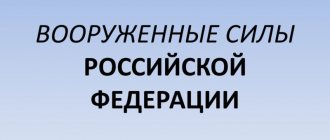Educational presentation “For children about the branches of the Russian military” for older preschoolers
Progress of the presentation
Slide 2, 3.
Our Army is strong and invincible because it protects our homeland on land, in the sea and in the sky. Types of armed forces of the Russian Federation: ground forces, navy and aerospace forces.
Slide 4.
Ground forces repel enemy attacks from the ground. These include: infantry, tank troops, artillery (rocket troops).
Slide 5.
Infantry is the most ancient and massive branch of the military; it is designed to conduct combat operations on foot. Today, infantry can use motorized vehicles and modern weapons: rifles, machine guns, anti-tank grenade launchers, armored vehicles with automatic guns.
Slide 6.
The basis of the tank forces are tank brigades and tank battalions of motorized rifle brigades. They are very mobile and powerful, their main task is active combat operations day and night, in a significant separation from other troops, defeating the enemy in oncoming battles and battles, and shooting at long distances.
Slide 7.
The missile forces are armed with modern missiles that fire very far and accurately. They are located on mobile platforms, so they can fly from any part of the country. Mobile platforms also house cannons or cannon systems to protect ground forces from air attack. Russian artillery stands reliably in defense of the Motherland.
Slide 8.
The Navy repels the enemy from the sea and protects the maritime borders of our state. It includes: submarine forces, naval aviation, marines and surface forces.
Slide 9.
While underwater, missile and torpedo submarines are able to strike the enemy unnoticed. Captains, sailors and divers serve on the submarine, and meals are prepared for them by cooks (cooks in the navy).
Slide 10.
These are huge platforms (aircraft carriers) in the ocean, on which several military aircraft can be located at once. Aircraft of naval forces are used to destroy the enemy's surface fleet, as well as to collect intelligence information. While on the water, they boldly stand guard over Russia.
Slide 11.
The Russian Navy has many large, modern ships at its disposal. Their mission is to destroy enemy forces on the high seas and on the shore. The Marines go ashore and fight on land. Victory over the enemy depends on their preparedness and strength.
Slide 12.
The task of the air force (aerospace forces) is to ensure the security and protection of the country's territorial interests in the air. In addition, they are designed to protect the administrative, industrial and economic centers of Russia. Their purpose is to protect other troops and ensure the success of operations. With their help, aerial reconnaissance, landing and destruction of enemy positions are carried out. They include: aviation, space forces, radio engineering and special forces.
Slide 13.
The purpose of military transport aviation is to deliver cargo and troops to the landing site. Moreover, food and medicines and military equipment can act as cargo. Provides air support to ground forces during any combat operations and destroys enemy aircraft in the air.
Slide 14.
Even in space there are Russian troops capable of ensuring the security of our country. Spaceships can prevent missile attacks and monitor important objects. Space defense forces are located throughout Russia at modern cosmodromes.
Slide 15.
Without them, it is impossible to collect enough information about the enemy. Radio technical troops conduct reconnaissance and monitor the movement of all aircraft in the skies over Russia. They use large radars to determine where the enemy is, how fast they are, and where they are going.
Slide 16.
Slide 17.
A lot of people work in the armed forces of the Russian Federation to ensure peace and order in our country.
LET'S THANK THEM SO MUCH!
Conclusion
After watching the presentation, you can invite the children to make a “Sailor” craft.
Source
Types and types of troops of the Armed Forces of the Russian Federation. - presentation
Types and branches of troops of the Armed Forces of the Russian Federation
Currently, the Armed Forces of the Russian Federation consist of three types of the Armed Forces, three branches of the armed forces, the Logistics Service of the Armed Forces of the Russian Federation, the Quartering and Arrangement Service of the Ministry of Defense, railway troops and other troops not included in the branches of the Armed Forces.
Ground forces are a type of armed forces designed to conduct combat operations primarily on land. In most countries they form the basis of their military power. The ground forces of the Russian Federation are capable, in cooperation with other types of forces, of conducting an offensive in order to defeat the enemy group and seize its territory, deliver fire strikes to great depths, repel the enemy’s invasion, its large airborne assault forces, and hold occupied territories, areas and lines. The ground forces of the Russian Federation include types of troops: motorized rifle, tank, missile troops and artillery, military air defense, army aviation; special troops, military units and logistics institutions. Ground troops.
The most numerous branch of the military, forming the basis of the Ground Forces, the core of their combat formations. They are equipped with powerful weapons to destroy ground and air targets, missile systems, tanks, artillery and mortars, anti-tank guided missiles, anti-aircraft missile systems and installations, and effective reconnaissance and control equipment. Motorized rifle troops
Tank troops constitute the main striking force of the Ground Forces and powerful means of armed warfare, designed to solve the most important tasks in various types of military operations.
Strategic Missile Forces (RVSN) are a branch of the Armed Forces of the Russian Federation. Designed for nuclear deterrence of possible aggression and destruction of strategic targets that form the basis of the enemy’s military and military-economic potential. Created in They are armed with intercontinental combat missile systems of various types, equipped with nuclear weapons. The Strategic Missile Forces include stationary and mobile missile forces, as well as special troops (units and units of missile technology, nuclear technology, engineering, radiation, chemical and biological protection, communications, electronic warfare, geodetic, meteorological, security and reconnaissance), units and transport aviation and logistics units. The Strategic Missile Forces consist of missile armies and special forces. Strategic Missile Forces.
Air defense troops (air defense).
Corps of Engineers. Engineering troops carry out tasks of installing mine-explosive barriers, anti-personnel, anti-vehicle and anti-tank mines, creating non-explosive barriers, making passages in enemy mine-explosive barriers, neutralizing and destroying mines and landmines, participate in the construction of bridges, crossings, fortified positions, pillboxes, bunkers, construction of rock roads, laying paths for equipment and personnel in hard-to-reach places. In reconnaissance and sabotage groups, sappers may be tasked with mining or blowing up bridges, crossings, railways, missile launchers, communications facilities, as well as laying mines and land mines on the approach routes of enemy reserves and other tasks.
The Air Force (VVS) is a branch of the armed forces designed to conduct reconnaissance of enemy groups; ensuring the conquest of supremacy (in the air; protection from air strikes of important military-economic areas (objectives) and groupings of forces; warning of an air attack; destruction of objects that form the basis of the enemy’s military potential; air support for ground forces and naval forces; airborne landings ; transportation of troops and materiel by air. The main striking force of the Russian Air Force is combat aircraft, bombers, fighters and attack aircraft, capable of delivering missile and bomb attacks on ground targets and effectively conducting air battles. After unification with the troops. In peacetime, the Air Force provides security state border of the Russian Federation in the airspace. Air Force.
Space forces are a branch of the military designed to warn of a nuclear missile attack, provide communications, and monitor the state of the space group. Created in 2001 by decision of the Security Council of the Russian Federation on the basis of formations and units for launching and controlling spacecraft of the Strategic Missile Forces, as well as missile and space defense troops. The tasks of the space forces include visual and electronic reconnaissance (in particular, early receipt of data on the preparation of the armed forces of foreign states for an attack), providing space information to all branches of the military and the country's leadership. Space Forces.
Airborne troops (Airborne Forces) are a branch of ground forces designed to drop (land) from the air behind enemy lines and conduct combat operations. The Airborne Forces consist of parachute, tank, artillery, self-propelled artillery and other units and subunits. The Airborne Forces are the real combat power of our Great Motherland. The actions of the landing force are fast, precise and deadly for the enemy. The Airborne Forces have repeatedly proven their strength and their heroism in military conflicts in all parts of the world, including in our homeland. Airborne troops (VDV).
Navy is a naval force (Navy), a type of armed force designed to conduct combat operations in various areas of the World Ocean. Includes types of forces: surface and submarine forces, naval aviation, coastal missile and artillery troops, marine infantry, air defense forces (air defense), logistics troops, etc. The Russian Navy is designed to destroy enemy fleet groups at sea and at coastal bases, for launching nuclear strikes on its ground targets, to combat maritime communications, to assist ground forces in operations in continental theaters of military operations, to land amphibious assault forces, as well as to repel enemy landings. The Russian Navy is divided into strategic nuclear forces and general purpose forces. Organizationally, the Navy includes: the Northern, Baltic, Black Sea, Pacific fleets, and the Caspian flotilla. Navy
Border troops are troops intended to protect the land, sea and river (lake) borders of the state. In the Russian Federation, they have been part of the FSB since March 2003. Border Service of the FSB of Russia.
The troops of the Ministry of Emergency Situations are engaged in preventing and eliminating the consequences of natural disasters. Primary restoration of the infrastructure of the affected areas, provision of assistance to the population. Troops of the Ministry of Emergency Situations and Civil Defense of Russia
Troops of the Federal Agency for Government Communications and Information (FAPSI) Troops monitoring government communication lines and delivering information.
Railway troops. Railway troops are special troops for the restoration, construction and operation of railways used for military transport.
Internal troops of the Ministry of Internal Affairs of Russia The Ministry of Internal Affairs is responsible for monitoring law and order within the country - these are our police, the prosecutor's office and other services that protect our security from internal attacks.
Glavspetsstroy The most peaceful army profession: the construction of bridges, roads, communications and communication lines for both the needs of the army and the population.
Radiation, Chemical and Biological Defense Troops (RKhBZ). The main purpose of the RCBZ troops of the Russian Armed Forces is to organize the protection of troops, the population and rear facilities from radiation, chemical and biological hazards both in peacetime and in war and to provide RCBZ property. Currently, environmental problems have become particularly relevant. Environmental disasters in the modern world have become a reality, and their consequences are comparable to the use of weapons of mass destruction.
Automobile troops. Designed for transporting personnel, supplying ammunition, fuel, food and other materiel necessary for combat operations, as well as for evacuating the wounded, sick, and equipment. In addition, automobile troops can transport troops that do not have their own vehicles.
Ground troops
From the history of creation
Ground forces are the oldest type of troops. In the era of the slave system, they consisted of two types of troops (infantry and cavalry) or only one of them. The organization and tactics of these troops received significant development in Ancient Rome, where a coherent system of their recruitment, training and use was created. In the VIII - XIV centuries. the use of handguns and artillery sharply increased the combat power of the ground forces and caused changes in the tactics of their actions and organization. In the XVII-XVIII centuries. Ground forces in various countries, including Russia, received a harmonious permanent organization, which included platoons, companies (squadrons), battalions, regiments, brigades, divisions and army corps. By the beginning of the First World War, ground forces constituted the bulk of the armed forces of most countries. By this time, they received repeating rifles with bayonets, heavy and light machine guns, rapid-fire guns, mortars, armored vehicles, and at the end of the war, tanks. The troops were united into armies, consisting of corps and divisions. The further creation and introduction of new types of weapons into the troops caused a change in the structure of the ground forces. They included armored, chemical, automobile and air defense troops.
Organizational structure of the Ground Forces
- High Command
- Motorized rifle troops
- Tank forces
- Rocket Forces and Artillery
- Air defense troops
- Intelligence units and military units
- Corps of Engineers
- Radiation, chemical and biological defense troops
- Signal Corps
Ground troops
- This is a type of troops intended primarily for conducting combat operations on land. In most states they are the most numerous, diverse in weapons and methods of warfare, and have great firepower and striking power. They are capable of conducting an offensive in order to defeat enemy troops and seize its territory, deliver fire strikes to great depths, repel enemy invasions, and firmly hold occupied territories and lines.
- These troops include:
- motorized rifle troops,
- tank forces,
- missile forces and artillery,
- air defense troops,
- units and units of special forces,
- units and institutions of the rear.
Motorized rifle troops
- the most numerous branch of the military. They consist of motorized rifle formations, units and subunits and are designed to conduct military operations independently or jointly with other branches of the military and special forces. They are equipped with powerful weapons to destroy ground and air targets, and have effective reconnaissance and control means.
Tank forces
designed to conduct combat operations independently and in cooperation with other branches of the military and special forces. They are equipped with tanks of various types (high cross-country tracked combat vehicles, fully armored, with weapons to destroy various targets on the battlefield). Tank troops constitute the main striking force of the ground forces. They are used primarily in the main directions to deliver powerful and deep blows to the enemy. Possessing great firepower, reliable protection, great mobility and maneuverability, they are capable of achieving the ultimate goals of combat and operation in a short time.
Rocket Forces and Artillery
- a branch of the military created in the early 60s. based on the artillery of the Ground Forces and the introduction of missile weapons into the troops. They serve as the main means of nuclear and fire destruction of the enemy and can destroy nuclear attack weapons, enemy force groups, aviation at airfields, and air defense facilities; hit reserves, control points, destroy warehouses, communications centers and other important objects. Combat missions are carried out using all types of fire and missile strikes. In addition to missile systems, they are armed with artillery systems, which, according to their combat properties, are divided into cannon, howitzer, jet, anti-tank and mortar systems, according to methods of movement - into self-propelled, towed, self-propelled, transportable and stationary, and according to design features - into barreled, rifled , smoothbore, recoilless, jet, etc.
Air defense troops
carry out tasks to repel enemy air attacks, cover troops and rear facilities from air strikes. Air defense is organized in all types of combat during troop movements and positioning on site. It includes reconnaissance of the air enemy, alerting troops about him, combat operations of anti-aircraft missile units and anti-aircraft artillery, aviation, as well as organized fire of anti-aircraft weapons and small arms of motorized rifle and tank units.
Special troops
— these are military formations, institutions and organizations designed to support the combat activities of the Ground Forces and solve special problems. These include engineering troops, radiation, chemical and biological defense troops, communications troops and others, as well as weapons and logistics services.
Source: Website of the Ministry of Defense of the Russian Federation https://www.grandars.ru/shkola/bezopasnost-zhiznedeyatelnosti/suhoputnye-voyska-rf.html
Types of the Armed Forces of the Russian Federation
Armed Forces of the Russian Federation (Russian Armed Forces)
- a state military organization of the Russian Federation, designed to repel aggression directed against the Russian Federation - Russia, for the armed defense of the integrity and inviolability of its territory, as well as to carry out tasks in accordance with international treaties of Russia.
A branch of the Armed Forces is an integral part of the Armed Forces of the Russian Federation, distinguished by special weapons and designed to perform assigned tasks, as a rule, in any environment (on land, in water, in the air).
From August 1, 2015, the Russian Armed Forces include the following types of armed forces:
✑ Ground Forces ✑ Aerospace Forces ✑ Navy.
Each branch of the Armed Forces consists of combat arms (forces), special troops and logistics.
Ground troops
Aerospace Forces (VKS)
Navy




